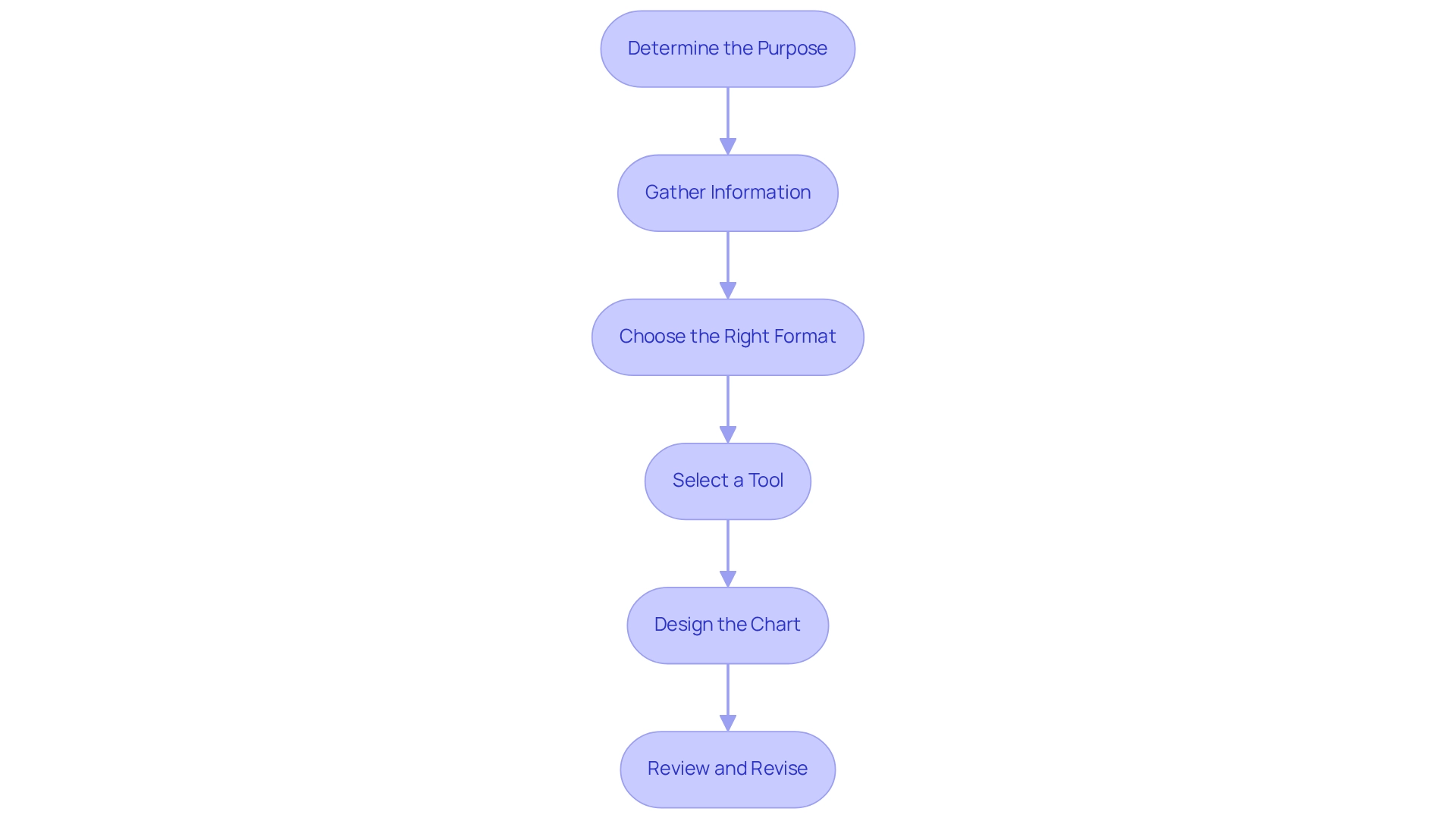
Overview
Creating an effective company org chart? You might be wondering where to start! It’s all about:
- Understanding its purpose
- Gathering accurate information
- Picking the right tools
- Following a structured design process
This article breaks down these steps and highlights how crucial it is to keep clarity, accountability, and strategic alignment in mind. After all, these elements not only enhance communication but also boost operational efficiency. So, let’s dive in and explore how you can make this process work for you!
Key Highlights:
- Organizational charts visually represent a company's framework, clarifying roles and responsibilities.
- They enhance accountability, communication, and onboarding for new employees.
- Org charts aid in strategic planning by identifying staffing needs and operational inefficiencies.
- Effective diagrams promote transparency and alignment with company goals, especially during growth.
- Steps to create an org chart include determining purpose, gathering information, choosing format, selecting tools, designing the chart, and reviewing for accuracy.
- Popular tools for creating org charts include Lucidchart, Microsoft Visio, SmartDraw, and Organimi, each offering unique features.
- Common challenges in org chart development include inaccurate data, complex structures, lack of clarity, resistance to change, and technical issues.
- Proactive solutions for these challenges involve regular updates, simplified structures, clear formatting, effective communication, and utilizing support resources.
Introduction
In the busy world of modern business, you might be wondering why understanding your organization's structure is so important. Well, it’s all about fostering clarity and enhancing communication! An organizational chart is like a roadmap for your company, visually mapping out the relationships and hierarchies that define everyone’s roles. This article is here to explore why org charts matter, outlining their benefits in clarifying responsibilities, making onboarding smoother, and supporting strategic planning.
Now, let’s dive into how you can create effective charts! We’ll provide you with a step-by-step guide, highlight some handy tools you can use, and address common challenges you might face along the way. By embracing the power of organizational charts, your company can streamline operations, improve team dynamics, and get ready for future growth. Sounds exciting, right?
Define the Organizational Chart and Its Importance
Have you ever looked at a structure diagram and thought, 'What’s the point?' Well, let me tell you, is more than just a fancy chart; it serves as a visual representation of a company's framework, illustrating how different roles and departments connect and rank. This tool does some pretty important things:
- First off, it clarifies roles and responsibilities. By mapping out reporting lines, a company org chart example aids you and your colleagues in understanding your roles, which significantly boosts accountability and clarity. A clear company org chart example facilitates communication with the right people about the right issues, which reduces confusion and helps everything run smoothly. If you’re new to a company, these diagrams are a lifesaver. They give you a quick peek into how the company is organized, making your transition a whole lot easier and helping you fit in faster.
- And let’s not forget about strategic planning! Org diagrams are key for spotting staffing shortages and areas that need improvement. They help companies focus their recruitment efforts and enhance operational efficiency. By mapping out individual employees, organizations can pinpoint skills and experience gaps, making sure that hiring is targeted and effective.
- But the value of structural diagrams goes beyond just looking nice; they’re strategic tools that boost clarity and efficiency. Companies that utilize a company org chart example often report better communication and a clearer understanding of roles, which is super important as businesses grow and departments start to overlap. Plus, by visualizing the current structure, companies can gear up for future growth, ensuring they stay aligned with their objectives and promoting transparency.
- Take, for example, a case study called 'Visualizing Growth and Enhancing Transparency.' It shows how companies that effectively use structure diagrams can prepare for scaling operations and keep all employees on the same page with the company's goals. Ultimately, not only clarify roles but also enhance overall business management and operations. As George Eldon Ladd put it, 'It appears likely that there was no normative pattern of church government in the apostolic age,' which underscores how vital structure is in any organization, including modern businesses.
Outline Steps to Create an Effective Org Chart
Creating a company org chart example is easier than you might think! Let’s break it down into some essential steps that will help you ensure clarity and functionality:
- Determine the Purpose: First things first—what’s the reason behind your organizational diagram? Whether it’s to clarify roles internally, help onboard new hires, or navigate a restructuring, knowing your purpose will guide your design choices.
- Gather Information: Next up, you’ll want to collect all the juicy details about employee roles, reporting relationships, and departmental structures. This might mean chatting with colleagues or sending out surveys to get accurate info, which is super important since company dynamics can shift pretty quickly.
- Choose the Right Format: Now, let’s talk formats! You’ll need to pick the type of organizational diagram that best showcases your organization’s structure. Options include hierarchical, matrix, or flat formats. For instance, a matrix structure lets staff report to different supervisors based on project needs, boosting flexibility and adaptability in project-oriented settings.
- Select a Tool: Don’t forget to utilize modern software applications for creating and updating your diagrams, like Lucidchart, Microsoft Visio, or Canva. These tools make the design process a breeze and allow for real-time collaboration and easy sharing. Once you’re done customizing, you can export your creations in various formats like PDF, PNG, and HTML.
- Design the Chart: Start with the top of the organization (think CEO) and work your way down, layering in management and staff. Keep it clear and readable by maintaining consistent spacing and alignment throughout the diagram.
- Review and Revise: Finally, share your draft with key stakeholders for feedback. This collaborative approach helps catch any inaccuracies or areas for improvement, allowing for necessary tweaks before finalizing the diagram.
By following these steps, you can create a company org chart example that not only illustrates your structure but also enhances operational efficiency. As Bill Clinton once said, "The cost of maintaining is significantly greater than the cost of transformation," which really emphasizes the importance of flexibility in our frameworks. Plus, understanding the difference between an arrangement diagram and structural organization is key—the former visually depicts the broader framework of task distribution and authority. So, are you ready to dive in and create your own chart?

Identify Tools and Software for Org Chart Creation
You might be wondering what tools are available for creating example. Well, there are quite a few options, each with unique features that cater to different needs. Let’s dive in!
First up is Lucidchart. This cloud-based diagramming tool really shines when it comes to collaboration. It offers templates that make teamwork a breeze, simplifying the whole process of creating a company org chart example. And guess what? Customer reviews even account for 10% of its total score in the evaluation criteria, which speaks volumes about its effectiveness.
Next, we have Microsoft Visio. If you’re already in the Microsoft 365 ecosystem, this one’s a powerhouse. It provides robust diagramming features, including a company org chart example, and integrates smoothly with other Microsoft applications—definitely a solid choice for those already using Microsoft products. It offers customizable templates for organizational diagrams, including a company org chart example, making it super accessible, even for those who might not have a design background. This collaborative online whiteboard platform allows teams to create organizational diagrams in real-time, boosting communication and teamwork, especially for those working remotely.
Don’t overlook SmartDraw either! It comes packed with a variety of templates and automation features, which really simplify the org structure creation process and can meet a range of business needs.
Lastly, let’s talk about Organimi. This tool is specifically designed for managing org structures and serves as a company org chart example, making it easy to create and maintain hierarchical diagrams. It’s particularly beneficial for larger entities. Kimberlee Henry points out that OrgChart is also a specialized software provider that helps HR professionals get the customizations they need for their organizational tasks.
When you're choosing the right tool, think about your company's size, complexity, and specific requirements. There’s a growing trend towards tools that incorporate AI and machine learning, which can enhance customization and collaboration while keeping things secure. As highlighted in the case study 'Trends in Org Tools for 2025,' these trends indicate a shift towards more advanced and customizable org tools that support agile structures—perfect for addressing the needs of a distributed workforce. As organizations evolve, the demand for sophisticated organizational layout solutions that facilitate agile frameworks is on the rise.
Troubleshoot Common Challenges in Org Chart Development
You might be wondering about the challenges of developing an organizational diagram and how they can impact its effectiveness. Let’s dive into some common issues and explore ways to tackle them together!
First up is Inaccurate Data. Keeping information about roles and relationships up-to-date is super important. Regular evaluations and tweaks to the organizational structure help reflect personnel changes and adjustments accurately. Did you know that 62% of employees have unauthorized data access? That’s a big deal when it comes to the risks of outdated information! Using SowFlow's user guide creation tools can really streamline this process, making sure your documentation is always fresh and easy to find.
Now, let’s talk about Complex Structures. In larger organizations, the web of relationships can get pretty intricate, right? One way to simplify things is by breaking the organizational diagram into smaller, manageable sections or using a layered approach for better clarity. The great news is that SowFlow’s platform makes it easy to update and revise your diagrams as your organization evolves.
Next, we have the issue of Lack of Clarity. A cluttered diagram can confuse more than it clarifies. To boost readability, stick to consistent formatting, limit the number of levels displayed, and ensure titles are clear and concise. With SowFlow, you can whip up user guides that provide clear instructions on how to read the organizational diagram, which really enhances understanding.
Then there’s Resistance to Change. It’s not uncommon for employees to push back against new structures. To help everyone get on board, it’s key to communicate the benefits clearly and involve team members in the development process. Remember, as the quote goes, "Data governance is the compass that directs entities towards data quality excellence, ensuring that every piece of information is a valuable asset for decision-making." SowFlow can assist in this communication by offering that outlines changes and their perks.
Lastly, let’s not forget about Technical Issues. Being familiar with your chosen software is essential to avoid hiccups. Make sure to leverage tutorials and support resources to troubleshoot effectively. SowFlow’s user-friendly interface and support resources empower teams to tackle these challenges confidently.
By proactively addressing these challenges, you can create a more effective and user-friendly company org chart example that enhances clarity and operational efficiency. This approach not only helps operations managers standardize processes but also supports co-workers in crafting standard operating procedures (SOPs) with ease.
Conclusion
You might be wondering just how important organizational charts are for your business. Well, understanding their significance is key if you want to boost clarity and communication within your team. These visual tools do more than just clarify roles and responsibilities; they also make onboarding smoother and aid in strategic planning. By putting effective org charts into action, you can streamline operations, enhance team dynamics, and set the stage for future growth.
Creating an effective org chart isn’t just a walk in the park, though. It involves some important steps, like:
- Figuring out the purpose
- Gathering accurate information
- Choosing the right tools
Thankfully, modern software can make this process a breeze, allowing for real-time collaboration and updates—something that’s crucial in today’s fast-paced business world. Plus, by recognizing and tackling common challenges in org chart development, like data accuracy and complexity, you can really boost their effectiveness.
At the end of the day, organizational charts are powerful tools that promote transparency and alignment within your company. By embracing their potential, you can not only improve internal communication but also set yourself up for long-term success in a competitive landscape. As your business evolves, strategic use of org charts will remain essential for navigating change and driving operational efficiency. So, why not take a closer look at how you can make org charts work for you?
Frequently Asked Questions
What is the purpose of a company org chart?
A company org chart serves as a visual representation of a company's framework, illustrating how different roles and departments connect and rank. It clarifies roles and responsibilities, aids in communication, and helps new employees understand the company's organization.
How does an org chart enhance accountability and clarity?
By mapping out reporting lines, an org chart helps individuals understand their roles and responsibilities, which boosts accountability and clarity. It facilitates communication with the right people about relevant issues, reducing confusion.
In what ways does an org chart assist in strategic planning?
Org charts are essential for identifying staffing shortages and areas needing improvement. They help companies focus recruitment efforts and enhance operational efficiency by pinpointing skills and experience gaps.
What benefits do companies experience by utilizing org charts?
Companies that use org charts often report better communication and a clearer understanding of roles, which is crucial as businesses grow. Org charts also help visualize the current structure and prepare for future growth while promoting transparency.
Can you provide an example of how org charts can be beneficial?
A case study titled "Visualizing Growth and Enhancing Transparency" demonstrates how companies effectively using structure diagrams can prepare for scaling operations and keep employees aligned with the company's goals.
Why is structure important in organizations?
Structure is vital in any organization, including modern businesses, as it clarifies roles, enhances overall business management, and improves operations, ensuring that everyone is on the same page regarding the company's objectives.
👍
What others are liking
5 Steps to outline your ideal documentation structure
5 MINS READ
Where to start the your journey of mapping out your ideal documentation structure, aligning it with the very heartbeat of your organization?
Defining a winning level of detail in your process
3 MINS READ
What is too much detail, and what is too little? This article described in that winning level detail about what detail is enough.





